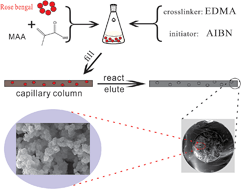Sensitive determination of rose bengal in brown sugar by a molecularly imprinted solid-phase extraction monolithic capillary column coupled with capillary electrophoresis
Abstract
A method employing molecularly imprinted solid-phase extraction (MISPE) coupled with capillary electrophoresis laser-induced fluorescence detection (CE-LIF) was developed for the determination of rose bengal in brown sugar. The rose bengal imprinted monolithic column was prepared by in situ polymerization, utilizing rose bengal as a template, methacrylic acid as a functional monomer and ethylene dimethacrylate as a cross-linker. The capacity and specificity of this column were evaluated by CE-LIF, and the morphology was characterized by scanning electron microscopy. The recoveries ranged from 89.7% to 90.3% (relative standard deviation 3.6–4.5%, n = 5). The capacities of the molecularly imprinted polymer and non-imprinted polymer columns were 1.314 μg mg−1 and 0.531 μg mg−1, respectively. The detection limit (S/N = 3) was 3 ng mL−1. The enrichment factor was higher than 63-fold and the MISPE column managed to remove rose bengal from the matrix of brown sugar effectively. This method can be applied to sensitively and effectively determine rose bengal in brown sugar.


 Please wait while we load your content...
Please wait while we load your content...